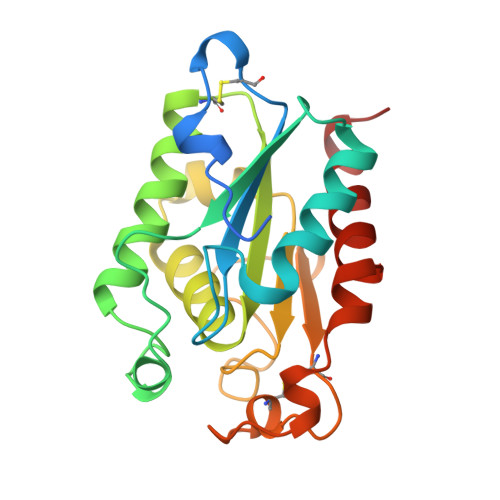Contribution of cutinase serine 42 side chain to the stabilization of the oxyanion transition state.
Nicolas, A., Egmond, M., Verrips, C.T., de Vlieg, J., Longhi, S., Cambillau, C., Martinez, C.(1996) Biochemistry 35: 398-410
- PubMed: 8555209
- DOI: https://doi.org/10.1021/bi9515578
- Primary Citation of Related Structures:
1FFA, 1FFB, 1FFC, 1FFD, 1FFE - PubMed Abstract:
Cutinase from the fungus Fusarium solani pisi is a lipolytic enzyme able to hydrolyze both aggregated and soluble substrates. It therefore provides a powerful tool for probing the mechanisms underlying lipid hydrolysis. Lipolytic enzymes have a catalytic machinery similar to those present in serine proteinases. It is characterized by the triad Ser, His, and Asp (Glu) residues, by an oxyanion binding site that stabilizes the transition state via hydrogen bonds with two main chain amide groups, and possibly by other determinants. It has been suggested on the basis of a covalently bond inhibitor that the cutinase oxyanion hole may consist not only of two main chain amide groups but also of the Ser42 O gamma side chain. Among the esterases and the serine and the cysteine proteases, only Streptomyces scabies esterase, subtilisin, and papain, respectively, have a side chain residue which is involved in the oxyanion hole formation. The position of the cutinase Ser42 side chain is structurally conserved in Rhizomucor miehei lipase with Ser82 O gamma, in Rhizopus delemar lipase with Thr83 O gamma 1, and in Candida antartica B lipase with Thr40 O gamma 1. To evaluate the increase in the tetrahedral intermediate stability provided by Ser42 O gamma, we mutated Ser42 into Ala. Furthermore, since the proper orientation of Ser42 O gamma is directed by Asn84, we mutated Asn84 into Ala, Leu, Asp, and Trp, respectively, to investigate the contribution of this indirect interaction to the stabilization of the oxyanion hole. The S42A mutation resulted in a drastic decrease in the activity (450-fold) without significantly perturbing the three-dimensional structure. The N84A and N84L mutations had milder kinetic effects and did not disrupt the structure of the active site, whereas the N84W and N84D mutations abolished the enzymatic activity due to drastic steric and electrostatic effects, respectively.
- Laboratoire de Cristallographie et Cristallisation des Macromolécules Biologiques, URA1296-CNRS, IFR1, Marseille, France.
Organizational Affiliation:
















